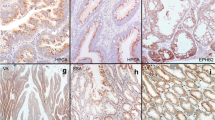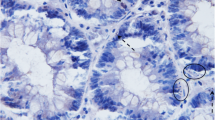Abstract
Purpose
Serrated adenomas (SAs), which include a wide spectrum of lesions, can be broadly divided into two subtypes: type I, closely mimicking hyperplastic polyps (HPs), and type II, unequivocal adenomatous tumor. Our preliminary findings showed clinicopathologic differences between them. The present study was conducted to investigate apoptotic activity and expression of the cell cycle regulator proteins p21WAF1/CIP1 and p27Kip1 in type I and II SAs, as compared with traditional adenomas (TAs) and HPs.
Methods
Apoptotic activity was estimated in hematoxylin-eosin stained specimens, and p21WAF1/CIP1 or p27Kip1 immunoreactivity was determined in 62 SAs (19 type I and 43 type II), 50 TAs and 19 HPs. The numbers (percentages) of apoptotic or immunoreactive cells were counted per 1,000 epithelial cells in equally separated crypt zones (upper, middle, and lower thirds).
Results
The apoptotic activity in the middle, but not the upper or lower crypt zone was higher in type II SAs (median 0.2%, interquartile range 0.1–0.5%) than in HPs (0.1%, 0.1–0.2%, P<0.01), whereas it was lower in type I SAs (0.2%, 0.1–0.3%) than in TAs (0.5%, 0.2–0.6%, P<0.001). P21WAF1/CIP1 expression in the lower crypt zone was higher in both type I and type II SAs (19.8%, 7.0–33.2% and 20.4%, 3.9–47.8%, P<0.0001) than in TAs (1.2%, 0.6–5.2%), and a similar tendency was also observed for the middle crypt zone. p27Kip1 expression did not vary among the groups.
Conclusions
The differences in apoptotic activity and p21WAF1/CIP1 expression between SAs and TAs or HPs indicate that SA should be considered as a distinct subtype of colorectal neoplasm. The two subtypes of SA do not differ in these parameters despite specific clinicopathological features.






Similar content being viewed by others
References
Ajioka Y, Watanabe H, Jass JR, Yokota Y, Kobayashi M, Nishikura K (1998) Infrequent K-ras codon 12 mutation in serrated adenomas of human colorectum. Gut 42:680–684
Akino F, Mitomi H, Nakamura T, Ohtani Y, Ichinoe M, Okayasu I (2002) High apoptotic activity and low epithelial cell proliferation with underexpression of p21WAF1/CIP1 and p27Kip1 of mucinous carcinomas of the colorectum. Comparison with well-differentiated type. Am J Clin Pathol 117:908–915
Ansari B, Coates PJ, Greenstein BD, Hall PA (1993) In situ end-labelling detects DNA strand breaks in apoptosis and other physiological and pathological states. J Pathol 170:1–8
Ban S (1999) Small hyperplastic polyps of the colorectum showing deranged cell organization: a lesion considered to be a serrated adenoma? Am J Surg Pathol 23:1158–1160
Ciaparrone M, Yamamoto H, Yao Y, Sgambato A, Cattoretti G, Tomita N, Monden T, Rotterdam H, Weinstein IB (1998) Localization and expression of p27KIP1 in multistage colorectal carcinogenesis. Cancer Res 58:114–122
Cordon-Cardo C (1995) Mutation of cell cycle regulators. Biological and clinical implications for human neoplasia. Am J Pathol 147:545–560
Doglioni C, Pelosio P, Laurino L, Macri E, Meggiolaro E, Favretti F, Barbareschi M (1996) p21/waf1/cip1 expression in normal mucosa and in adenomas and adenocarcinomas of the colon: its relationship with differentiation. J Pathol 179:248–253
Frankfurt OS, Robb JA, Sugarbaker EV, Villa L (1996) Monoclonal antibody to single-stranded DNA is a specific and sensitive cellular marker of apoptosis. Exp Cell Res 226:387–397
Fujishima N (1996) Proliferative activity of mixed hyperplastic adenomatous polyp/serrated adenoma in the large intestine, measured by PCNA (proliferating cell nuclear antigen). J Gastroenterol 31:207–213
Gavrieli Y, Sherman Y, Ben-Sasson SA (1992) Identification of programmed cell death in situ via specific labeling of nuclear DNA fragmentation. J Cell Biol 119:493–501
Hiyama T, Yokozaki H, Shimamoto F, Haruma K, Yasui W, Kajiyama G, Tahara E (1998) Frequent p53 gene mutations in serrated adenomas of the colorectum. J Pathol 186:131–139
Jaramillo E, Watanabe M, Rubio C, Slezak P (1996) Small colorectal serrated adenomas: endoscopic findings. Endoscopy 28:1–3
Jass JR, Sobin LH (1989). WHO histological typing of intestinal tumours, 2nd edn. Springer, Berlin Heidelberg New York
Kang M, Mitomi H, Sada M, Tokumitsu Y, Takahashi Y, Igarashi M, Katsumata T, Okayasu I (1997) Ki-67, p53, and Bcl-2 expression of serrated adenomas of the colon. Am J Surg Pathol 21:417–423
Kerr JFR, Wyllie AH, Currie AR (1972) Apoptosis: a basic biological phenomenon with wide-ranging implications in tissue kinetics. Br J Cancer 26:239–257
Kobayashi T, Consoli U, Andreeff M, Shiku H, Deisseroth AB, Zhang W (1995) Activation of p21WAF1/Cip1 expression by a temperature-sensitive mutant of human p53 does not lead to apoptosis. Oncogene 11:2311–2316
Levine DS, Haggitt RC (1992) Colon. In: Sternberg SS, ed. Histology for pathologists. Raven Press, New York
Longacre TA, Fenoglio-Preiser CM (1990) Mixed hyperplastic adenomatous polyp/serrated adenomas. A distinct form of colorectal neoplasia. Am J Surg Pathol 14:524–537
Macleod KF, Sherry N, Hannon G, Beach D, Tokino T, Kinzler K, Vogelstein B, Jacks T (1995) p53-dependent and independent expression of p21 during cell growth, differentiation, and DNA damage. Genes Dev 9:935–944
Matsumoto T, Mizuno M, Shimizu M, Manabe T, Iida M (1999a) Clinicopathological features of serrated adenoma of the colorectum: comparison with traditional adenoma. J Clin Pathol 52:513–516
Matsumoto T, Mizuno M, Shimizu M, Manabe T, Iida M, Fujishima M (1999b) Serrated adenoma of the colorectum: colonoscopic and histologic features. Gastrointest Endosc 49:736–742
Michieli P, Chedid M, Lin D, Pierce JH, Mercer WE, Givol D (1994) Induction of WAF1/CIP1 by a p53-independent pathway. Cancer Res 54:3391–3395
Parker SB, Eichele G, Zhang P, Rawls A, Sands AT, Bradley A, Olson EN, Harper JW, Elledge SJ (1995) p53-independent expression of p21cip1 in muscle and other terminally differentiating cells. Science 267:1024–1027
Polyak K, Kato J, Solomon MJ, Sherr CJ, Massague J, Roberts JM, Koff A (1994) p27Kip1, a cyclin-Cdk inhibitor, links transforming growth factor-β and contact inhibition to cell cycle arrest. Genes Dev 8:9–22.
Rubio CA, Jaramillo E (1996) Flat serrated adenomas of the colorectal mucosa. Jpn J Cancer Res 87:305–309
Rubio CA, Rodensjö M (1995a) Flat serrated adenomas and flat tubular adenomas of the colorectal mucosa: differences in the pattern of cell proliferation. Jpn J Cancer Res 86:756–760
Rubio CA, Rodensjö M (1995b) p53 overexpression in flat serrated adenomas and flat tubular adenomas of the colorectal mucosa. J Cancer Res Clin Oncol 121:571–576
Sasaki K, Sato T, Kurose A, Ikeda E (1996) Immunohistochemical detection of p21waf1/cip1/sdi1 and p53 proteins in formalin-fixed, paraffin-embedded tissue sections of colorectal carcinoma. Hum Pathol 27:912–916
Sinicrope FA, Roddey G, Lemoine M, Ruan S, Stephens LC, Frazier ML, Shen Y, Zhang W (1998) Loss of p21WAF1/Cip1 protein expression accompanies progression of sporadic colorectal neoplasms but not hereditary nonpolyposis colorectal cancers. Clin Cancer Res 4:1251–1261
Strater J, Koretz K, Gunthert AR, Moller P (1995) In situ detection of enterocytic apoptosis in normal colonic mucosa and in familial adenomatous polyposis. Gut 37:819–825
Tateyama H, Li W, Takahashi E, Miura Y, Sugiura H, Eimoto T (2002) Apoptosis index and apoptosis-related antigen expression in serrated adenoma of the colorectum. The saw-toothed structure may be related to inhibition of apoptosis. Am J Surg Pathol 26:249–256
Torlakovic E, Snover DC (1996) Serrated adenomatous polyposis in humans. Gastroenterology 110:748–755
Viale G, Pellegrini C, Mazzarol G, Maisonneuve P, Silverman ML, Bosari S (1999) p21WAF1/CIP1 expression in colorectal carcinoma correlates with advanced disease stage and p53 mutations. J Pathol 187:302–307
Yao T, Kouzuki T, Kajiwara M, Matsui N, Oya M, Tsuneyoshi M (1999) 'Serrated adenoma' of the colorectum, with reference to its gastric differentiation and its malignant potential. J Pathol 187:511–517
Acknowledgments
We thank H. Shinoda, K. Yamashita, M. Yokozawa, K. Kubokawa, I. Yokoyama, T. Tatebayashi, T. Kuba, S. Yoshida, and T. Takahashi, Kitasato University East Hospital, for their expert technical assistance.
This work is supported in part by Health and Labour Sciences Research Grants for Research on Allergic Diseases and Immunology (A.M.).
Author information
Authors and Affiliations
Corresponding author
Additional information
Drs. Mitomi and Sada contributed equally to this study.
Rights and permissions
About this article
Cite this article
Mitomi, H., Sada, M., Kobayashi, K. et al. Different apoptotic activity and p21WAF1/CIP1, but not p27Kip1, expression in serrated adenomas as compared with traditional adenomas and hyperplastic polyps of the colorectum. J Cancer Res Clin Oncol 129, 449–455 (2003). https://doi.org/10.1007/s00432-003-0478-y
Received:
Accepted:
Published:
Issue Date:
DOI: https://doi.org/10.1007/s00432-003-0478-y




